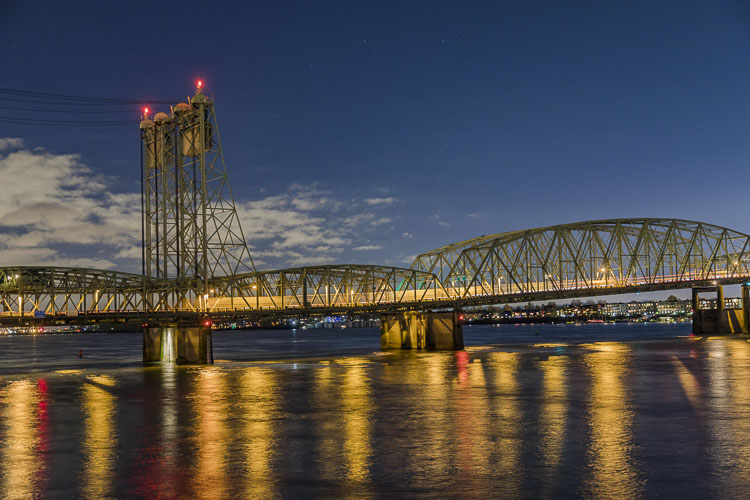
Disappointment at single auxiliary lane choice and failure to address congestion
John Ley
For Clark County Today
The Oregon and Washington legislators on the Bi-state Bridge Committee learned details related to the Interstate Bridge Replacement (IBR) program recommendations Friday. They were told the IBR proposal doesn’t always match up with what the data shows. Many pushed back on the recommendations of both light rail and a single auxiliary lane on the bridge.
On Nov. 18, 2019, Governors Jay Inslee and Kate Brown signed a Memorandum of Understanding, restarting a process to replace the Interstate Bridge. Both governors promised to be “data driven.” They said high capacity transit and tolling would be needed.
“We’re not setting pre-conditions for types of high capacity systems,” Inslee said. “We’re going to be driven by data, it will be a very thorough analysis of the alternatives, and we’ll have a vigorous discussion in our constituencies to see what their thoughts are.”
At that joint press conference held in Vancouver, Brown said: “I think what else is key is that we’re going to be doing a traffic analysis ahead of time to help us determine what’s the best solution for the I-5 Bridge Replacement Project.”
Two and a half years later, the Interstate Bridge Replacement (IBR) program and Administrator Greg Johnson shared its recommended proposal to the Executive Steering Group on Thursday, and the 16 members of the Bi-state Bridge Committee on Friday. In many ways, the proposal is less than what the failed Columbia River Crossing (CRC) offered a decade ago.

“It doesn’t always align, it doesn’t always match up with what we see from the data,” deputy program manager John WIllis told the Bi-state Bridge Committee of legislators.
The recommendation includes three through lanes plus one auxiliary lane for merging and weaving, in each direction. The recommendation includes an exit directly on to Hayden Island for southbound I-5 traffic, whereas northbound vehicles will exit at Marine Drive. Light rail is the recommended form of mass transit.
Several legislators from both states pushed back on what they heard. Sen. Lynda Wilson (Republican, 17th District) decried the shrinking project as well as the choice of light rail. “We are reducing this thing to practically what we have right now,” she said.
“Two auxiliary lanes seems like the right decision,” Wilson said. “So how much more time could we save, or how much less congestion could we have If we have the two (auxiliary lanes)?” she asked. No answer was provided.
Willis responded to a question from Rep. Sharon Wylie, (Democrat, 49th District) who asked about safety considerations of one versus two auxiliary lanes. “We tend to look at safety by looking at it nominally,” he responded. “Can we provide the space, safety as a predictor and a model is very hard to predict.”
Sen. Ann Rivers, (Republican, 18th District) highlighted the fact that Washington and Oregon are net export states. The diminished number of lanes will harm freight haulers.
“I share Senators Rivers and Wilson’s concerns about the limitation on the lanes we’re putting on the bridge,” said Sen. Lee Beyer (Democrat, 6th District). Beyer was involved in the previous CRC project. “It would make some sense to have another lane there, particularly if it was a dedicated freight lane.”
He reminded the committee they are building the bridge for the next 100 years. “It doesn’t hurt to have a little extra capacity.”
Transportation architect Kevin Peterson believes I-5 will have about 180,000 daily vehicle movements in 2030, creating a need of between five and six lanes in each direction. By 2045, he saw the need for between seven and eight lanes in each direction on the corridor.
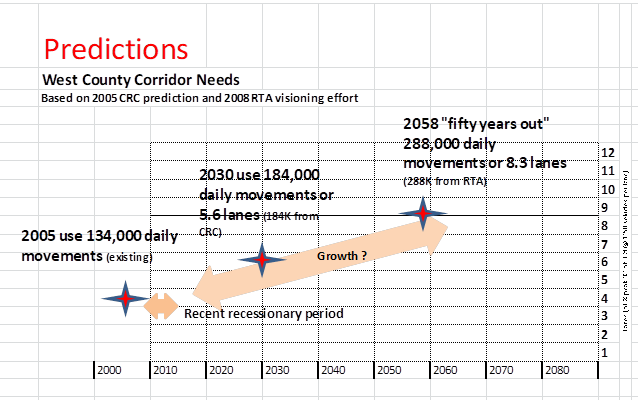
“I think that would make a lot of sense and probably addresses some of the concerns of those who are concerned about expanding capacity,” Beyer said.
Beyer pointed out that auxiliary lanes made a significant difference in reducing traffic congestion on both I-205 and on OR-217 in Beaverton. “I was skeptical. But I will tell you, they made a heck of a difference, because a lot of the traffic was sort of an in and out in both of those sections,” he said. “It certainly improved through traffic.”
The Oregon proposal for the Abernethy Bridge on I-205 will add one new lane in each direction between the bridge and Stafford Road. ODOT tells citizens the combination of adding new lanes and tolling will eliminate 12 hours of traffic congestion each day. That is in stark contrast to the IBR proposal.
Several members of the committee were absent when roll call was taken at the beginning of the meeting. Washington Sen. Marko Liias (Democrat, 21st District), Rep. Brandon Vick (Republican 18th District), and Rep. Jake Fey (Democrat, 27th District), were not present, in addition to Oregon Sen. Brian Boquist (Republican, 12th District).
“This new project is actually worse than the old project,” Rivers said. “So I guess this falls in the broad heading of . . . be careful what you kill, because maybe the next thing that comes along isn’t any better or perhaps is even worse.”
Oregon Rep. Shelly Boshart Davis (Republican, 15th District) questioned the staff assertion that light rail was cheaper than buses. “You say generally, that it has a lower per rider cost,” she said. “Do you have a percentage? Is that generally 10 percent or 50 percent? Is it twice as cheap?”
The staff didn’t have an answer. “I don’t want to misquote a number,” said IBR’s Frank Green. “That’s a number we could probably get and share with the committee.”
During citizen comments, the answer was provided. TriMet’s cost of MAX light rail is $8.24 per rider, 51 percent more than C-TRAN’s $5.44 cost per rider on its bus rapid transit (BRT).
Boshart Davis was also unhappy with the process where she thought they were being asked to approve the project when there were so many unanswered questions.
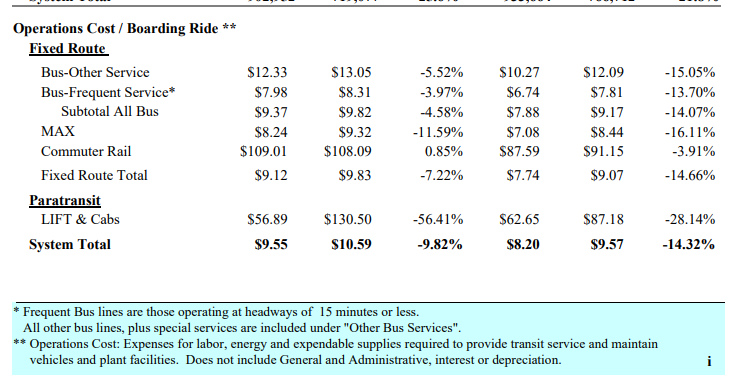
Light rail for transit
“Capacity on light rail allows the program to maximize trips,” Willis said. “The light rail transit provides a more competitive travel time compared to trips that require a transfer at Expo.” Unaddressed was the fact that a transfer would have to happen somewhere, be it time lost at a park and ride, or transferring from another C-TRAN bus.
“For this particular scenario, light rail transit would be more competitive for that federal discretionary funding that we are searching for as part of the overall financing and funding of the program,” he told legislators.
Yet a day before, C-TRAN CEO Shawn Donaghy refuted that narrative. He questioned the statement about the Federal Transit Administration (FTA) preferring to fund light rail over bus rapid transit (BRT). “There really is no one mode that is more effective at getting public transit funding than the other,” he said Thursday.
“I just want to make a comment about something that was mentioned in the transit portion, which is the statement that light rail has the ability to (get) federal funding better than BRT does,” Donaghy said. “I would say that’s very specific to this project, and not necessarily a function of FTA funding, I think you’re seeing the FTA move a lot more toward BRT projects, because they’re cheaper. They’re a little more effective on certain aspects of other transit systems, or even our transit system, for example.”
Additional pushback on the choice of extending MAX light rail into Vancouver came from Senator Wilson. She noted that TriMet has forecast it will take six years before ridership returns to pre pandemic levels, and that none of the light rail trains or buses are full. Apparently TriMet recently provided a more optimistic ridership recovery projection that the IBR staff couldn’t explain.
Wilson had previously expressed concerns about the choice of light rail for transit. “Before the bridge is built, can we look at these numbers then and decide what we need to do?” she asked. Once the tracks are laid down, it’s permanent, she had noted.
Boshart Davis noted that no dollar amounts on the cost were provided for citizens to consider when providing input on a transit mode. “I think we did use relative terms and describing investments without using actual amounts,” Willis responded.
Auxiliary lanes and freight mobility
Willis shared that the two auxiliary lane option created more space for merging and weaving. He later said that two auxiliary lanes provided more safety than one. “Zero aux lanes, we think is the less safe solution,” he said. “One provides a lot of safety advantages, and two is incrementally more than that.”
IBR’s Ray Maybe shared that the average trip length is 16 miles, while the average truck trip length is 20 miles. People’s travels stay largely within this region. The data is from the Metro traffic model.
Truck volumes through this corridor are “heavy and high” Maybe reported. “In fact, they’re about six times higher than our typical design criteria for trucks. We have 12 percent trucks through this corridor,” he said.
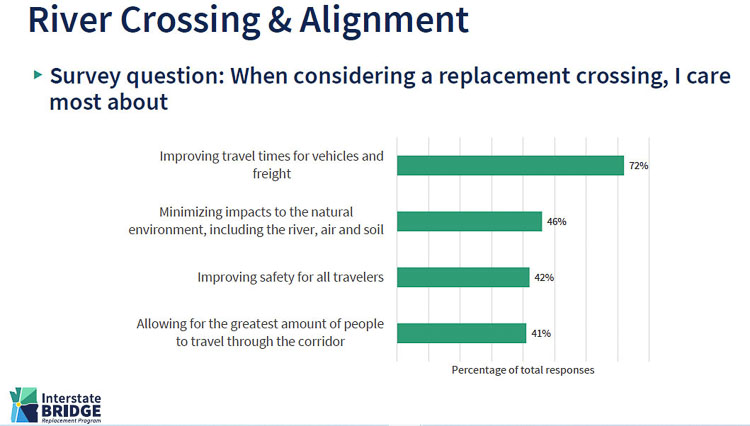
Freight mobility issues were discussed, as several people noted the importance of keeping truckers moving. Yet overall, the freight haulers will be stuck in traffic congestion twice as long in 2045 as they are today, after spending up to $5 billion on the recommended solution.
“We’re supposed to be dealing with congestion and freight mobility,” Wilson said. ”This isn’t gonna get us there. I’m really concerned that every single time we have another meeting, the footprint gets smaller and smaller. So now we’re going from two auxiliary lanes to one auxiliary lane.
“We don’t really know what it’s going to cost until months or years down the line before we start building it,” Wilson said. “And then it may be obsolete, because we’re not even considering autonomous cars, which in 100 years are going to be probably what everybody’s driving or not driving. So I’m really concerned about how this is all playing out.”
Beyer asked what the effect would be of adding a dedicated freight lane. Willis indicated they would be working with both ports. “We want to continue with both of our port partners to understand as we get into design, how we can make freight movement as easy as possible,” he said.
A day earlier, Lynn Valenter, co-chair of the IBR’s Community Advisory Group (CAG), said she was overwhelmed at the “less than stellar improvement” in morning commute times. “Disappointment is the mildest word I can use,” she said.
Morning travel times will double on I-5 according to the IBR team. Presently, it takes 29 minutes to travel from the I-205 interchange in Vancouver to the I-405 interchange in Portland. That will take 60 minutes in 2045, with the addition of one auxiliary lane. Similarly, it currently takes 16 minutes to travel from 99th Street in Vancouver to Victory Blvd. in Portland. It will take 33 minutes in 2045 with the project’s recommendation.
A different perspective indicates that 50 percent of vehicles will be traveling at zero to 20 mph during peak travel times, with only one auxiliary lane. Presently, 28 percent of vehicles are traveling that slow during rush hour commutes.
Willis summarized feedback provided by the Community Advisory Group. “We really want to maximize the capacity and minimize congestion,” he reported. Earlier surveys reported 78 percent of Clark County residents prioritized saving time and reducing traffic congestion.
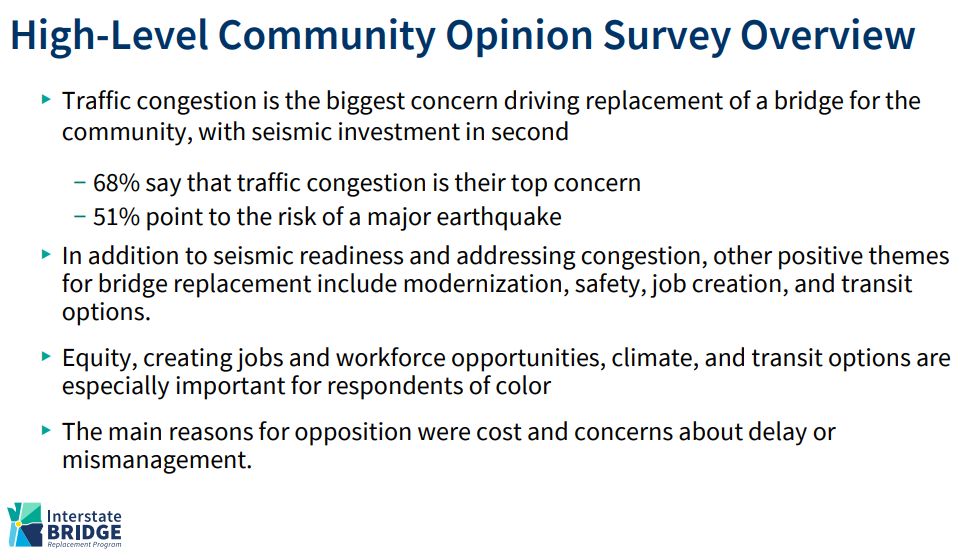
Community input favors two auxiliary lanes
Willis shared that the Community Advisory Group gave feedback saying they really wanted an option that maximizes capacity and minimizes congestion. They believed two auxiliary lanes was the right choice.
Residents also favored the two auxiliary lanes by a slim majority. Clark County residents were more likely to select the two auxiliary lane option, according to Willis.
Sen. Lynn Findley, (Republican, 30th District) asked about a new, recent community survey that was reported. “Sixty one percent support in Washington and Vancouver doesn’t seem very high to me, I don’t, I would not classify that as strong.” He wanted to know the sample size and other details.
Willis indicated it was over 1,000 people and had a margin of error of between four and eight percent.
Multiple earlier public surveys showed transit overall getting less than half as much support as relieving traffic congestion for citizens’ top concern.
A formal, more scientific survey was conducted in late November and early December 2020 by FM3 Research. It had a margin of error of plus or minus 3.3 percent. The results appear to mirror other government agency surveys on people’s priorities, and were reported to the ESG in February 2021.
Traffic congestion topped voters’ concerns, with 68 percent saying it is very or extremely concerning. A major earthquake was second with 51 percent very or extremely concerned. The survey canvassed 917 registered voters in Clark, Clackamas, Multnomah and Washington counties. According to IBRP staff, they over-sampled people of color and Clark County citizens.
Overall, the cost of the project was people’s largest concern when asked an open-ended question. Fully 35 percent of respondents stated cost concerns. Next was “continued delays” at 22 percent and “government mismanagement” at 19 percent. At the bottom of the list was “will not include public transit” at just 2 percent.
Which series of surveys should legislators and citizens believe?
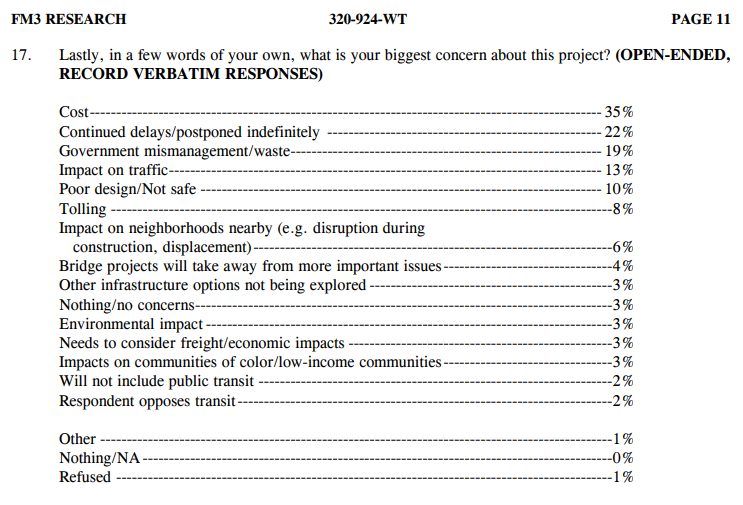
In the FM3 survey for the IBR, people were asked, are things in the Portland/Vancouver region generally headed in the right direction, or are they on the wrong track? The majority, 56 percent, said “wrong track,” with just 29 percent saying “right track.” Fifteen percent chose to not answer.
Asked to rank a list of nine issues as problems or concerns, “lack of public transportation” came in dead last, with only 14 percent saying it was extremely serious or a very serious problem. One up from the bottom was “lack of transportation choices other than driving” at 19 percent.
Paul Harris, (Republican, 17th District) asked about the overall width of the bridge and what the difference would be for two auxiliary lanes versus one. Willis gave a non-answer, replying that a single lane was normally 12 feet wide.
Rep. Susan McLain (Democrat, 29th District) was worried about delays, due to all the questions being asked. “Nothing gets cheaper if we wait even a week or five weeks or three years,” she said. “The program recommendation is just the starting point for the environmental review. We will either see if the elements that we consider to be pillar elements can be built and or produced with the results that we say we want in our criteria review.”
Johnson followed up by reminding the legislators his team is only at the 2 percent of design phase. They will continue to study things as they proceed through the environment review process. “It’s a very excellent point that we will be digging in deeper and asking more questions about this recommendation,” he said. “Are there fatal flaws and that will drive us to a different type of solution?”
“This right now is just a recommendation of what to study and see if it works,” Johnson said.
“I’m encouraged to hear Greg say that we can still investigate things that might expand lanes, increasing safety, increased freight movement, that kind of thing as we move forward,” said Rivers. She begged the indulgence of her fellow committee members. Several members “are feeling like much of what we have requested hasn’t been reflected in the locally preferred alternative,” she said.




